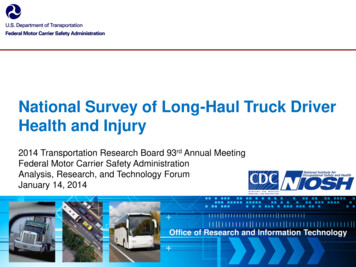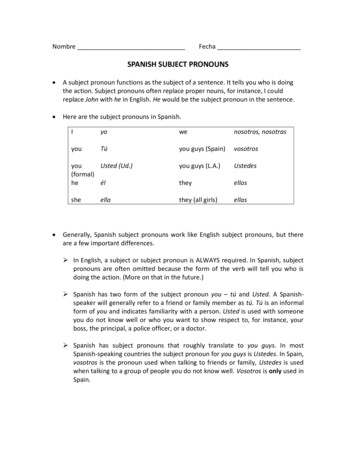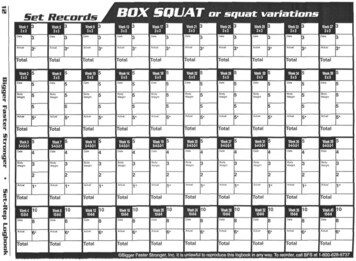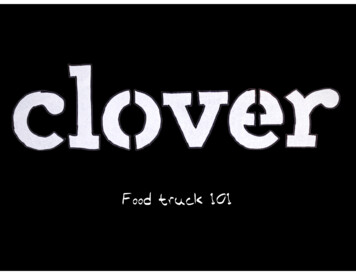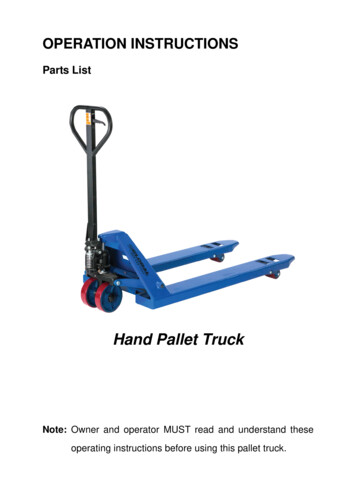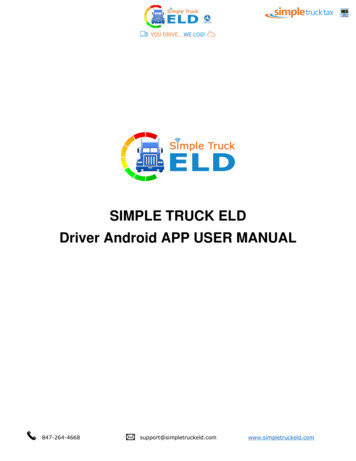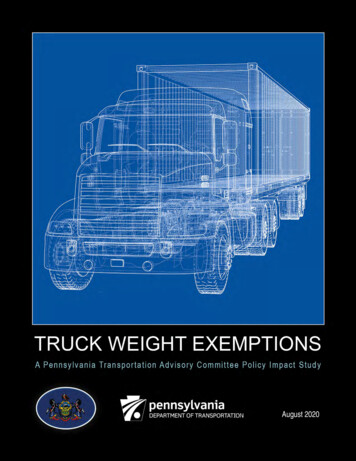
Transcription
August 2020
ACKNOWLEDGEMENTSpage iACKNOWLEDGEMENTSAbout the Transportation Advisory CommitteeThe Pennsylvania Transportation Advisory Committee (TAC) wasestablished in 1970 by Act 120 of the State Legislature, which alsocreated the Pennsylvania Department of Transportation (PennDOT).TAC has two primary duties. First, it "consults with and advises the StateTransportation Commission and the Secretary of Transportation onbehalf of all transportation modes in the Commonwealth." In fulfilling thistask, TAC assists the Commission and the Secretary "in thedetermination of goals and the allocation of available resources amongand between the alternate modes in the planning, development, andmaintenance of programs, and technologies for transportation systems.”TAC’s second duty is "to advise the several modes (about) the planning,programs, and goals of the Department and the State TransportationCommission." TAC undertakes in-depth studies on important issues andserves as a liaison between PennDOT and the general public.TAC consists of the following members: the Secretary of Transportation;the heads (or their designees) of the Department of Agriculture,Department of Education, Department of Community and EconomicDevelopment, Public Utility Commission, Department of EnvironmentalProtection, and the Governor's Policy Office; two members of the StateHouse of Representatives; two members of the State Senate; and 18public members—six appointed by the Governor, six appointed by thePresident Pro Tempore of the Senate, and six appointed by the Speakerof the House of Representatives.Transportation Advisory CommitteeHonorable Jody L. Holton, AICPChairAssistant General ManagerSEPTAHonorable Yassmin Gramian, P.E.SecretaryPA Department of TransportationHonorable Gladys M. Brown DutrieuilleChairPA Public Utility CommissionHonorable Dennis M. DavinSecretaryPA Department of Community and Economic DevelopmentHonorable Meg SneadDirector of Planning and PolicyOffice of the GovernorPENNSYLVANIA TRANSPORTATIONADVISORY COMMITTEETRUCK WEIGHT EXEMPTIONS STUDYAugust 2020
ACKNOWLEDGEMENTSpage iiHonorable Patrick McDonnellSecretaryPA Department of Environmental ProtectionHonorable Russell ReddingSecretaryPA Department of AgricultureHonorable Pedro A. RiveraSecretaryPA Department of EducationHonorable Kim WardSenate of PennsylvaniaMajority Chair of SenateTransportation Comm.Alt: Nolan R. RitchieHonorable Timothy P. KearneySenate of PennsylvaniaTransportation Comm.Alt: Sam ArnoldHonorable Tim HennesseyPa House of Rep.Majority Chair of House Transportation Comm.Alt: Josiah ShellyHonorable Mike CarrollPa House of Rep.Minority Chair of HouseTransportation Comm.Alt: Meredith BiggicaMr. Michael Carroll, P.E.Office of Transportation and Infrastructure SystemsCity of PhiladelphiaMs. Felicia DellDirector of PlanningYork County Planning CommissionMr. Donald L. DetwilerNew Enterprise Stone and Lime Co., IncBedford CountyMr. Thomas C. GeanopulosMarketing Consultant (ret.)Allegheny CountyMr. Joel B. McNeilBrookville EquipmentJefferson CountyMr. Mark MurawskiLycoming County Transportation PlannerLycoming CountyPENNSYLVANIA TRANSPORTATIONADVISORY COMMITTEETRUCK WEIGHT EXEMPTIONS STUDYAugust 2020
ACKNOWLEDGEMENTSpage iiiMr. John Pocius, P.E., PLSLaBella AssociatesLackawanna CountyMr. L. Ashley Porter, P.E.Porter Consulting Engineers, P.C.Crawford CountyThe TAC acknowledges thecontributions of the variousstakeholders who helped to informand broaden our understanding ofthis topic and to sharpen ourperspectives as to its complexity.It is important to recognize theinvolvement of the rail industry andJerry Vest who coordinated theinvolvement of severalPennsylvania railroads.Finally, the TAC was saddened tolearn of the passing of KevinStewart of the PA Motor TruckAssociation during the conduct ofthe study. His contributions,insights, and commitment toPennsylvania transportation madeso very late in his life contribute tohis lasting legacy.Ms. Karina RicksDirector, Department of Mobility and InfrastructureCity of PittsburghMs. Brenda A. SandbergExecutive Director at Erie-Western PA Port AuthorityErie CountyMr. Jeffrey J. StroehmannJDM ConsultantsUnion CountyMr. Alan Blahovec, CCTMExecutive Director, Westmoreland County Transit AuthorityWestmoreland CountyMr. Charles F. Welker, P.E.EADS Group, Inc. (ret.)Blair CountyMr. Larry J. Nulton, Ph.D.Nulton Aviation Services, Inc.Cambria CountyMr. Elam HerrPennsylvania State Association of Township Supervisors (retired)Lancaster CountyMr. Kevin StewartPennsylvania Motor Truck AssociationCumberland CountyMr. Ron G. WagenmannManager, Upper Merion Township (retired)Montgomery CountyPENNSYLVANIA TRANSPORTATIONADVISORY COMMITTEETRUCK WEIGHT EXEMPTIONS STUDYAugust 2020
CONTENTSpage ivCONTENTSKEY TERMINOLOGY. vSECTION 1 – BACKGROUND AND STUDY OBJECTIVES . 1SECTION 2 – FINDINGS . 8SECTION 3 – CONSIDERATIONS GOING FORWARD. 36BIBLIOGRAPHY . 40PA 581, Cumberland CountyPENNSYLVANIA TRANSPORTATIONADVISORY COMMITTEETRUCK WEIGHT EXEMPTIONS STUDYAugust 2020
KEY TERMINOLOGYpage vKEY TERMINOLOGYExemption – For purposes of this study, “exemption” is a statutorily approvedcommodity category of truck movement exceeding Pennsylvania’s80,000-pound weight limit.PennDOT issued atemporary specialhauling permitexemption to supportPennsylvania’s disasteremergency response tothe COVID-19pandemic.It should be noted that PennDOT’s special hauling permit process allowsfor very few true “exemptions” from the statutory 80,000-pound weightlimit. Each truck movement exceeding weight and size limits requires aspecial hauling permit, except those outlined in Chapter 49 (Size, Weightand Load), Title 75 (Pennsylvania Vehicle Code).PennDOT issued a temporary special hauling permit exemption in April2020 in response to the COVID-19 pandemic. Exemption 2020-13Atemporarily exempted weight and permitting requirements for motorcarriers transporting goods and materials necessary to support GovernorWolf’s Proclamation of Disaster Emergency. Specifically, motor carriersutilizing combination vehicles with divisible load limits equal to or lessthan 90,000 pounds were exempt from vehicle weight and permittingrequirements provided the transport directly assisted disaster emergencyresponse. According to PennDOT’s Special Hauling Permits Manager,the exemption was extended through June 30, 2020. However, it is beingmonitored and is subject to change in the future.Special Hauling Permit – Special Permit for Excessive Weight & Size asspecified in Chapter 49 (Size, Weight and Load), Title 75, issued fortruck movements exceeding Pennsylvania’s statutory 80,000-poundweight limit. For purposes of this study, “special hauling permit” issynonymous with “exemption.”Class I Railroads – Each Class I railroad operates in multiple states overthousands of miles of track. They are the largest railway carriers andaccount for most of the rail infrastructure in the country, according to theAssociation of American Railroads.The nation’s seven Class I railroads are BNSF Railway Co., CSXTransportation, Grand Trunk Corporation (Canadian National’soperations), Kansas City Southern Railway, Norfolk Southern, Soo LineCorporation (Canadian Pacific’s operations), and Union Pacific Railroad.Class II Railroads – These railroads are also known as a “regional railroads” andoften provide service spanning one or more regions.Class III Railroads These railroads are also known as a “shortline railroads”and typically provide localized shipping services connecting with largerrail carriers and or/intermodal facilities.Figure 1 on the following page maps Pennsylvania’s Class I, Class II, and ClassIII railroads.PENNSYLVANIA TRANSPORTATIONADVISORY COMMITTEETRUCK WEIGHT EXEMPTIONS STUDYAugust 2020
Figure 1: Pennsylvania Railroads by Class
SECTION 1 – BACKGROUNDpage 1SECTION 1 – BACKGROUND ANDSTUDY OBJECTIVESIntroductionSince 1994 when the Pennsylvania General Assembly enacted the firstlegislation allowing permit issuance for the hauling of an overweight load,23 additional exemptions have been enacted for a range of commoditiesand other goods (see Figure 2 on page 5).The legislation was enacted with the intent of supporting Pennsylvania’seconomy, and subsequent exemptions were backed by industry groupsand/or businesses with the objective of lowering shipping costs forcommodities or finished goods.Cost-effective transportation provides important economic benefits forvarious entities through the exemptions. However, benefits must beconsidered in a balanced manner, with a full understanding of theassociated costs—wear and tear on state and local roads and bridges,safety, economic harm to other entities, community impacts andenforcement, etc.This study is notintended to makerecommendations, butrather to begin framingfurther discussions andresearch to informdecision-makers.Concern has been raised by rail stakeholders and others that the totalcosts of overweight truck permitting have not been thoroughlyunderstood or considered, while the PA General Assembly hascontinued authorizing exemptions largely building on precedent. Theremay even be a perception that the issuance of the permit by PennDOTaddresses the full range of potential issues and concerns, which is notthe case. The permit application process enables PennDOT staff toreview oversize and overweight loads and the proposed routes theywould take while being moved through Pennsylvania, but this review isaimed at roadways most appropriate for these movements based onwhether the infrastructure can generally accommodate vehicles of theproposed size and weight, and whether there are construction closuresor other issues that may need to be considered in determining the mostappropriate route. Economic impacts, competitive concerns from othertransportation modes, and community impacts are not analyzed in detailas part of this process.Study Purpose and ScopeThe Pennsylvania Transportation Advisory Committee (TAC) undertookthis study as an initial assessment of the complex range of impacts oftwo decades of overweight truck permitting. These include damage tostate and local infrastructure, economic benefits as well as negativeconsequences, mode shift results, and safety concerns, among others.The work included identifying the extent and characteristics ofoverweight truck travel based on PennDOT permit data.As an initial policy impact study, the effort was intentionally broad ratherthan in-depth, recognizing that key topic areas would need to bePENNSYLVANIA TRANSPORTATIONADVISORY COMMITTEETRUCK WEIGHT EXEMPTIONS STUDYAugust 2020
SECTION 1 – BACKGROUNDpage 2examined further in any subsequent analyses. The study is not intendedto make recommendations, but rather to begin framing furtherdiscussions and research to inform decision-makers.Important: Consistent with TAC’s commitment to independent andobjective analysis, this study is neither pro-trucking nor pro-rail. The soleintent is to begin framing the broader issues and impacts of truck weightexemptions. Readers are strongly encouraged not to take statements outof context that might suggest favoring one mode over another. The fullreport must be considered as it reflects the balanced, neutral approachthat this initial broad-based analysis required.US 22/322, Perry CountyStudy MethodologyKey elements in the study process included:oStakeholder engagement to solicit the experience of the trucking andrail industries as well as safety and other perspectives.oAdditional information-gathering and interviews of state officials tounderstand Pennsylvania’s legislative background and currentpractices.oLiterature review to build on previous research efforts, includingthose at the federal level and by other states.oAnalysis of PennDOT permit data over a two-year period—more than905,000 records.The study team synthesized this quantitative, qualitative, and anecdotalinformation into nine core findings, which form the heart of this report.The final section of the report briefly offers considerations movingPENNSYLVANIA TRANSPORTATIONADVISORY COMMITTEETRUCK WEIGHT EXEMPTIONS STUDYAugust 2020
SECTION 1 – BACKGROUNDpage 3forward, to help guide Pennsylvania’s continued progress on thisimportant issue. The considerations could be a starting point for anyfuture targeted and in-depth analysis.Federal and State Regulations and PracticesThe purpose of this sub-section is to provide a general foundationaloverview of federal and state (Pennsylvania) laws and regulationsgoverning truck weight limits.Federal 1The applicable federal legislation governing truck weight limits is theSurface Transportation Assistance Act (STAA) of 1982 (P.L. 97-424).Under this statute, the general overall weight limit for a five-axle tractortrailer configuration with a 53-foot trailer (designated as a 3-S2configuration) was established as 80,000 pounds for the roadway systemdesignated as the STAA National Network. Other weight limits wereestablished for different truck and trailer configurations, but the five-axletractor-trailer combination is the predominant form of long-haul trucktransportation in the U.S. and the one most relevant to an analysisrelated to overall weight limits.A typical five-axle tractor-trailer combinationIn addition to the gross vehicle weight of 80,000 pounds, the federalregulations also include separate maximum weight limits of 20,000pounds on one axle and 34,000 pounds on a pair of tandem axles. Thefederal regulations also contain a series of restrictions tied to a BridgeGross Weight Formula that relates to axle loads and axle spacing. For1PENNSYLVANIA TRANSPORTATIONADVISORY COMMITTEEFederal-Aid Highway Act Amendments (1974) and 23 CFR Part 658.17TRUCK WEIGHT EXEMPTIONS STUDYAugust 2020
SECTION 1 – BACKGROUNDpage 4the purpose of this study, it should be assumed that any trucks operatingunder Pennsylvania weight exemptions either meet the applicableregulations related to the federal formula—or are not required to meetthem.The weight limits documented here can be described as a “minimumlimit” in that states are not permitted to establish lower weight limits thanthese on Interstate Highways except in limited circumstances. 2 Theseweight limits are applicable to the “National System of Interstate andDefense Highways and reasonable access thereto.” 3The federal regulations have one specific provision that relates to anInterstate Highway segment in Pennsylvania that was previously a U.S.Route. Under §658.17(m), the weight limits described above “shall notapply to the operation, on I-99 between Bedford and Bald Eagle,Pennsylvania, of any vehicle that could legally operate on this highwaysection before December 29, 1995.” In addition, there are other statutoryand regulatory exceptions to current size and weight limits establishedunder “grandfather” provisions related to the federal highway bills of1956, 1975, and 1991.A key exception to the 80,000-pound federal limit on Interstate highwaysinvolves “non-divisible” loads (such as a large construction crane). Statescan issue permits for trucks hauling non-divisible loads that exceed the80,000-pound limit. 4 A non-divisible load is one that would meet one ormore of the following conditions if it were separated into smaller loads:(a) would compromise the intended use of the vehicle; (b) would destroythe value of the load or vehicle; or (c) would require more than 8 workhours to dismantle.State (Pennsylvania)In Pennsylvania, each truck movement exceeding the statutory 80,000pound weight limit is required to be permitted by PennDOT. SpecialPermits for Excessive Weight & Size, or special hauling permits, requirean application and associated fee as specified in Chapter 49 (Size,Weight and Load) Title 75 (Pennsylvania Vehicle Code). Special haulingpermits may be issued for a vehicle or combination of vehicles exceedingweight limits. Permits are issued based on weight, dimension, route, andcurrent state and local road and bridge restrictions. Permits may beissued annually, seasonally, and by single trip with fee amounts varyingby load type.The regulations provide criteria for the movement of specific equipmentand/or commodities enabled through legislative authority. Since the1990s, legislation has been enacted to authorize the transport of 24commodities and equipment via an overweight load permit. Figure 2 lists2CFR §658.17(f)CFR §658.17(a)4 CFR §658.17(h)3PENNSYLVANIA TRANSPORTATIONADVISORY COMMITTEETRUCK WEIGHT EXEMPTIONS STUDYAugust 2020
SECTION 1 – BACKGROUNDpage 5these commodities and equipment, current maximum permitted weight,and the initial year legislation was enacted.Figure 2: Pennsylvania Legislative Authorization forOverweight Commodities & EquipmentCommodity/EquipmentContainerized t Enacted90,0001994Bulk Refined Oil107,0001998Construction Equipment135,0001998Limestone95,0001998Live Domestic Animals95,0001998107,0001998Waste Coal/Beneficial Combustion Ash95,0001998Course of Manufacture: Pulpwood/Wood Chips(5-Axle)95,0001999Course of Manufacture: Pulpwood/Wood Chips(6-Axle)107,000199996,9001999Course of Manufacture: Self Propelled Cranes(Road Tested)150,0001999Float Glass/Flat Glass100,0001999Building Structural Components116,0002001Course of Manufacture: Flat-Rolled Steel Coils orSteel ,000201095,0002010150,0002010Eggs95,0002012Course of Manufacture: Raw iberboardCourse of Manufacture: Raw WaterCourse of Manufacture: Raw CoalContainerized Cargo: Refrigerated Meat ProductsAnimal Feed/Unprocessed GrainNonhazardous Liquid GlueWaste TiresCourse of Manufacture: Hot Ingot/Hot BoxCourse of Manufacture: Cryogenic LiquidCourse of Manufacture: SugarAccording to PennDOT’s Special Hauling Permits Manager, PennDOTissues approximately 450,000 special hauling permits per year. Theseinclude permits for trucks that are operating above the posted weightlimit for any given route, along with those that are oversized (height,width, and/or length) but still operating at or below the posted weightlimit. The latter group is not included in this study.PENNSYLVANIA TRANSPORTATIONADVISORY COMMITTEETRUCK WEIGHT EXEMPTIONS STUDYAugust 2020
SECTION 1 – BACKGROUNDpage 6Approximately 80 percent of special hauling permit applications areissued through PennDOT’s automated permitting software, AutomatedPermit Routing Analysis System (APRAS). The remaining 20 percent areprocessed manually by PennDOT staff. APRAS, in place since 1998,analyzes truck movements and determines the route a truck carriershould use. The system takes road and bridge construction and closuresinto account. If there is a restriction along a route, the systemautomatically forwards the application to PennDOT staff for manualreview.Further details pertaining to the permit requirements for the commoditieslisted above may be found in PennDOT Publication 31, Special HaulingPermit Manual, and in PennDOT’s Load Type Quick Reference Guide:Load Type Quick Reference Guide.PENNSYLVANIA TRANSPORTATIONADVISORY COMMITTEETRUCK WEIGHT EXEMPTIONS STUDYAugust 2020
SECTION 1 – BACKGROUNDpage 7I-80, Clarion CountyPENNSYLVANIA TRANSPORTATIONADVISORY COMMITTEETRUCK WEIGHT EXEMPTIONS STUDYAugust 2020
SECTION 2 – FINDINGSpage 8SECTION 2 – FINDINGSFINDING 1PennDOT issued nearly 577,000 overweight permits over a two-yearperiod from 2016 to 2018; overweight and oversize permits yielded acombined 72 million in estimated revenue.FINDING 2Most truck weight-exempted travel under PennDOT permits originatesand ends in Pennsylvania.FINDING 3Truck weight exemptions accelerate deterioration of Pennsylvania’saging state and local road and bridge network. The cost of this damagecannot be determined using available data.FINDING 4Overweight truck permits may increase or decrease truck trips or truckmiles depending on the freight economics of the situation.FINDING 5Truck weight exemptions appear to shift a significant portion of heavytruck traffic off Interstate highways and onto state and local roads, raisingboth infrastructure and safety concerns.FINDING 6Shippers whose commodities are transported using overweight permittedtrucks are beneficiaries of the transport cost savings provided by theoverweight permits. But the economic benefits of overweight permittingare not distributed evenly across Pennsylvania businesses andresidents.FINDING 7Pennsylvania’s rail freight operators, particularly regionaland shortlines, are placed at a competitive disadvantage by some truckweight exemptions.FINDING 8Enforcement of truck weight limits is likely inconsistent acrossPennsylvania’s municipalities.FINDING 9Experiences of other states can help inform PA’s further evaluation oftruck weight exemptions.PENNSYLVANIA TRANSPORTATIONADVISORY COMMITTEETRUCK WEIGHT EXEMPTIONS STUDYAugust 2020
SECTION 2 – FINDINGSpage 9FINDING 1PennDOT issued nearly 577,000 overweight permits over atwo-year period from 2016 to 2018; overweight and oversizepermits yielded a combined 72 million in estimated revenue.OverviewThe findings related to PennDOT permits for this study were obtainedand derived through a review of detailed data from PennDOT’sAutomated Permit Routing and Analysis System (APRAS). PennDOTimplemented APRAS to streamline the permit application and reviewprocess, process payments from carriers obtaining permits, eliminatepaperwork, and provide analytical capability to assess the viability ofhighways and local roads to accommodate overweight and/or oversizedloads on specific routes.Note that PennDOTdata is based on thenumber of permits, notthe number of trucktrips.One seasonal or annualpermit may actuallyrepresent hundreds oftruck trips.PENNSYLVANIA TRANSPORTATIONADVISORY COMMITTEEAPRAS data provides a starting point for this broad study; however, ithas significant limitations that constrain analysis of overweight trucktraffic and impacts.Analysis APRAS data has important limitations.oThe data includes permits for oversize loads, which may or may notbe overweight. As a result, some of the computations used in TAC’sanalysis are an aggregation of all oversize and overweight loads, notjust overweight loads.oIt contains detailed information on permits, not individual truck trips.There is a direct correlation between a permit and a truck trip for asingle-trip permit, but not for seasonal and annual permits. Whenestimating the total number of overweight truck trips on thePennsylvania highway system over any given period of time, there isa high degree of uncertainty in the number of individual trips beingmade under seasonal and annual permits.oThe data doesn’t record all the details needed to estimateinfrastructure impacts. As discussed in Finding 3, actual wear-andtear to roads and bridges depends on more than the total weight of avehicle—it is a function of many factors, particularly the number andconfiguration of axles, and the characteristics of the infrastructuretraveled.TRUCK WEIGHT EXEMPTIONS STUDYAugust 2020
SECTION 2 – FINDINGSpage 10APRAS data does not capture the number of axlesA single-trip permit in APRAStypically includes a “start date”and “end date” approximately oneweek apart, giving the permitholder some flexibility in the exacttime when a permitted trip wouldbe made. Annual permits typicallycover a period of 364-365 days.For the purpose of this study, thepermits listed in the APRAS datafile were organized by duration,based on the followingparameters:Permits covering a period up to10 days are considered “singletrip” permits. These comprise526,515 of the records in theAPRAS overweight permit data,or 91.27 percent of the total. Permits covering a periodlonger than 200 days areconsidered “annual” permitsfor the purpose of thisanalysis. These comprise49,539 of the overweightpermit records, or 8.59percent of the total.The remainder of the permitscovering a duration of 10-200days comprise only 792 ofthe records, or 0.14 percentof the total.5PENNSYLVANIA TRANSPORTATIONADVISORY COMMITTEEWith the aforementioned limitations in view, APRAS data doesprovide a starting point for understanding overweight truck travel inPA.oPennDOT provided a series of APRAS data files covering a two-yearperiod from 8/23/2016 to 8/22/2018. A total of 905,050 records wereincluded in the two-year data output for actual overweight andoversize permits out of 907,351 applications originally submitted.oAbout 72.16 million of overweight and oversized permit fees werepaid to PennDOT for these applications.oThe APRAS data included 576,846 overweight permits, of which526,515 were single-trip permits that can be used to estimate costimpacts on the Pennsylvania roadway system associated withindividual truck trips.oThe average weight for overweight trucks operating under single-trippermits documented in the APRAS data file was 119,600 pounds. 5oTrucks operating with single-trip permits have an average trip lengthwithin Pennsylvania of 75.8 miles.oThose operating under “annual” permits have an average trip lengthof 19.0 miles within the state. All of the goods listed in Figure 2 aregranted annual permits except Building Structural Components,which are issued seasonal permits. Note that “ConstructionEquipment” as a general Load Type is an annual permit, butsubcategories such as cranes, etc., are not.APRAS data does not include travel on the Pennsylvania Turnpike system.TRUCK WEIGHT EXEMPTIONS STUDYAugust 2020
SECTION 2 – FINDINGSpage 11oThe average single-trippermit documented inthe APRAS data fileduring the analysisperiod was for a truckthat weighed 119,600pounds and traveled75.8 miles onPennDOT and localroads. Those trucks that operate under the remaining 792 permits (seesidebar) travel an average distance of 37.0 miles on Pennsylvaniaroads.PennDOT’s administrative costs for overweight and oversize permitprocessing for the two-year period is estimated at between 9million and 14 million.APRAS data indicates that 80 percent of the online applications areprocessed and approved automatically. The remaining 20 percent areprocessed by PennDOT staff and take an average of one hour toprocess. 6 Based on the 907,351 total applications documented above,this translates into an estimated staff administrative cost to PennDOT of 9.04 million to 13.57 million, assuming an hourly PennDOT staff costof 50 to 75 (this is a reasonable to conservative estimate if alloverhead costs are included). Issuance of special hauling permits is small in comparison to totaltruck movements.PennDOT issues approximately 450,000 permits for excessive weightand size (special hauling permits) each year, as documented above. Thisis a very small percentage of Pennsylvania’s total annual truck trips byany measure. Data compiled by the Federal Highway Administration andthe Bureau of Transportation Statistics indicates that more than 550million tons of freight are moved by truck to, from or withinPennsylvania. 7 Even a highly conservative assumption that all of thisfreight is moving in fully loaded 80,000-pound trucks, 8 and there are nopartially loaded or empty trucks on the highway system, would yield aminimum annual total of 24 million truck trips with an origin and/or adestination in Pennsylvania. 9The number of specialhauling permits issuedis small in comparisonto total truckmovements.6Pennsylvania Department of Transportation, Automated Permit Routing/Analysis System OnlineTraining Manual, Volume 2: Using APRAS, PennDOT Publication 393, Volume 2 (February 2010),page 6.7U.S. Department of Transportation, Federal Highway Administration, Bureau of TransportationStatistics, “Shipments Within, Outbound, and Inbound U.S. States – Tons by Trade Type &Transportation Mode: 2018,” Freight Analysis Framework (FAF) Version 4.5.1.8A tractor-trailer combination typically has a tare (empty) weight of about 35,000, so the calculationreferenced here is based on a 45,000-pound load in an 80,000-pound GVW truck.9This is not intended to be an accurate representation of total truck trips to, from, and withinPennsylvania, but to demonstrate the order of magnitude of overall truck trips compared to thenumber of trucks operating under special permits in Pennsylvania.PENNSYLVANIA TRANSPORTATIONADVISORY COMMITTEETRUCK WEIGHT EXEMPTIONS STUDYAugust 2020
SECTION 2 – FINDINGSpage 12FINDING 2Most truck weight-exempted travel under PennDOT permitsoriginates and ends in Pennsylvania.OverviewAccording to the two-year data review described in Finding 1, most of thetruck movements using PennDOT overweight permits serve shippersand/or receivers in Pennsylvania—62 percent of the permits had both anorigin and a destination in Pennsylvania. (Note: A cursory review of otherstates suggests that permit processes are comparable.)AnalysisMost of the truckmovements usingPennDOT overweightpermits serve shippersand/or receivers inPennsylvania.PENNSYLVANIA TRANSPORTATIONADVISORY COMMITTEE APRAS origin and destination data provide a profile of themovements of permitted overweight trucks.Of the permits analyzed (described in Finding 1):o76.0 percent are for origins in Pennsylvania.o20.7 percent have origins in neighboring states.o0.5 percent list the "PA Turnpike" as the origin.o2.7 percent have no origin listed.o74.3 percent have Pennsylvania destinations.o22.0 percent have destinations in neighboring states.o0.5 percent list the "PA Turnpike" as the destination.o3.2 percent have no destination listed.o62.2 percent have both an origin and a destination in Pennsylvania.o9.0 percent have both an origin and a destination in neighboringstates.o2.7 percent have neither an origin nor a destination listed.oAmong trips originating out of state, the most common entry pointsinto Pennsylvania are West Virginia (7.2 percent of the tot
According to PennDOT's Special Hauling Permits Manager, the exemption was extended through June 30, 2020. . while the PA General Assembly has continued authorizing exemptions largely building on precedent. . which is not the case. The permit application process enables PennDOT staff to review oversize and overweight loads and the proposed .
